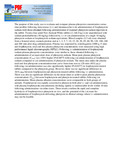| dc.contributor.author | Muchohi, S. N. | |
| dc.contributor.author | Kokwaro, G. O. | |
| dc.contributor.author | Maitho, T. E. | |
| dc.contributor.author | Munenge, R. W. | |
| dc.contributor.author | Watkins, W. M. | |
| dc.contributor.author | Edwards, G. | |
| dc.date.accessioned | 2013-04-16T12:01:03Z | |
| dc.date.available | 2013-04-16T12:01:03Z | |
| dc.date.issued | 2002 | |
| dc.identifier.citation | European journal of drug and Pharmacokinetics | en |
| dc.identifier.uri | http://www.ncbi.nlm.nih.gov/pubmed/12064376 | |
| dc.identifier.uri | http://erepository.uonbi.ac.ke:8080/xmlui/handle/123456789/16150 | |
| dc.description.abstract | The purpose of this study was to evaluate and compare plasma phenytoin concentration versus time profiles following intravenous (i.v) and intramuscular (i.m) administration of fosphenytoin sodium with those obtained following administration of standard phenytoin sodium injection in the rabbit. Twenty-four adult New Zealand White rabbits (2.1±0.4 kg) were anaesthetized with sodium pentobarbitone (30 mg/kg) followed by i.v or i.m administration of a single 10 mg/kg phenytoin sodium or fosphenytoin sodium equivalents. Blood samples (1.5 ml) were obtained from a femoral artery cannula predose and at 1, 3, 5, 7, 10, 15, 20, 30, 45, 60, 90, 120, 180, 240 and 300 min after drug administration. Plasma was separated by centrifugation (1000 g; 5 min) and fosphenytoin, total and free plasma phenytoin concentrations were measured using high performance liquid chromatography (HPLC). Following i.v administration of fosphenytoin sodium plasma phenytoin concentrations were similar to those obtained following i.v administration of an equivalent dose of phenytoin sodium. Mean peak plasma phenytoin concentrations (Cmax) was 158% higher (P=0.0077) following i.m administration of fosphenytoin sodium compared to i.m administration of phenytoin sodium. The mean area under the plasma total and free phenytoin concentration-time curve from time zero to 120 min (AUC0−120) following i.m administration was also significantly higher (P=0.0277) in fosphenytoin treated rabbits compared to the phenytoin group. However, there was no significant difference in AUC0−180 between fosphenytoin and phenytoin-treated rabbits following i.v administration. There was also no significant difference in the mean times to achieve peak plasma phenytoin-concentrations (Tmax) between fosphenytoin and phenytoin-treated rabbits following i.m administration. Mean plasma albumin concentrations were comparable in both groups of animals. Fosphenytoin was rapidly converted to phenytoin both after i.v and i.m administration, with plasma fosphenytoin concentrations declining rapidly to undetectable levels within 10 min following administration via either route. These results confirm the rapid and complete hydrolysis of fosphenytoin to phenytoin in vivo, and the potential of the i.m route for administration of fosphenytoin delivering phenytoin in clinical settings where i.v administration may not be feasible. | en |
| dc.language.iso | en | en |
| dc.relation.ispartofseries | Vol. 27 (2) pp. 83-89; | |
| dc.title | Pharmacokinetics of phenytoin following intravenous and intramuscular administration of fosphenytoin and phenytoin sodium in the rabbit | en |
| dc.type | Article | en |
| local.publisher | Department of Pharmacology and Pharmacognosy, School of Pharmacy, University of Nairobi | en |
| local.publisher | department of Public Health, Pharmacology, and Toxicology, University of Nairobi | en |

